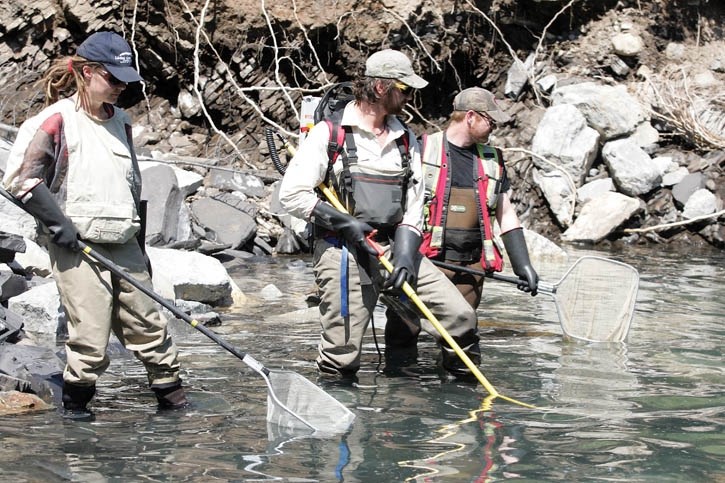As the water levels in Banff National Park’s Cascade River receded to merely a trickle last week when the Minnewanka spillway was closed, officials with Parks Canada and TransAlta rushed against time to save over 1,000 fish from dying as a result.
June flooding and historically high water levels in Minnewanka forced the hydro company to use the spillway for the first time since the dam was built in 1941.
The result was that one of the most manipulated rivers in the national park, Cascade, re-established itself through the landscape and connected with the Bow River downstream. With the river flowing, fish from the lake also found new habitat along the 13.5-kilometre stretch for 27 days while the spillway was open.
Parks Canada aquatics expert Charlie Pacas said 1,104 fish in total were relocated, however, there were some fish that weren’t saved.
“The salvage operation was successful,” Pacas said on Tuesday (July 30). “We did encounter some mortality on the stream edges when we first started doing our work, but we realized that was pretty probable given the amount of flow that we had.”
He said it is difficult to estimate mortality numbers for fish that didn’t survive other than the few hundred encountered at the beginning of the operation. “There was more than likely a few more than that.”
After closure of the spillway, the water levels in the river began to drop and pools formed. Parks Canada brought in 80 people including staff from all the western parks, consultants and biologists to spend five days searching those pools for fish using a technique called electro-fishing.
“The salvage plan was basically developed last week when we started realizing TransAlta was going to be turning off the water to the Cascade system,” Pacas said.
“If you give it the water, the water actually has a tremendous capacity to rearrange everything in the river. It was beautiful to actually see all the redistribution of silts and gravel and cobbles — even the debris looks really enhanced from the flood event.”
Glenn Isaac, TransAlta’s manager of environmental health and safety for its hydro division, said the company’s sustainability program is geared towards having a minimal environmental impact. The company, in fact, is covering the cost of the salvage operation, although it has refused to release that information publicly.
“In my 20-year career I have never seen a fish salvage this large and I probably never will again in my life — it is big — it is huge,” Isaac said last Thursday (July 27) while standing beside the diminished flows of the river. “It is a big initiative for us and we are extremely happy it is going on and with what we are seeing so far — it is a success.
“This part of the program will be ending this week, but as we move forward we will be working with Parks to figure out the next steps and like everything related to the floods, we can’t really give it a definitive timeframe, it is very dynamic.”
Even with the spillway closed, the Cascade hydro plant is still not operational. In an email, TransAlta spokesperson Jessi-Ann Riddell said the water levels in the reservoir have stabilized and are at seasonal levels.
In order to repair the hydro facility’s equipment, those levels had to decrease in order for access. Riddell said once the turbines are assessed and repaired, the units will be retuned to service, but at this time there is no estimated date for that to occur.
TransAlta’s hydro power plant on the Cascade River is the only power development in a Canadian national park. It is part of the Bow River electric system and generates an average of 52,000 megawatt hours each year.
Riddell indicated the company has an emergency response plan for its hydro facilities, including possible scenarios to assist in quick and safe planning during an emergency like a fish salvage operation. That plan, however, is confidential and not available to the public.
Pacas, meanwhile, said fish salvage operations should be avoided, especially in a national park.
“I think we should avoid it where possible, it just means handling fish and typically handling is stressful for fish. It is also stressful for people who have to handle the fish,” he said. “Sometimes they have to work in stressful situations; ideally, if we don’t have to do it and we could keep fish happy in their water environments, we are way better off.”
In total, 12 species of fish were identified as part of the rescue operation. Those include brook, bull, brown, lake, rainbow and cutthroat trout, Rocky Mountain whitefish and lake whitefish, longnose daces, white suckers, longnose suckers and ciscos.




